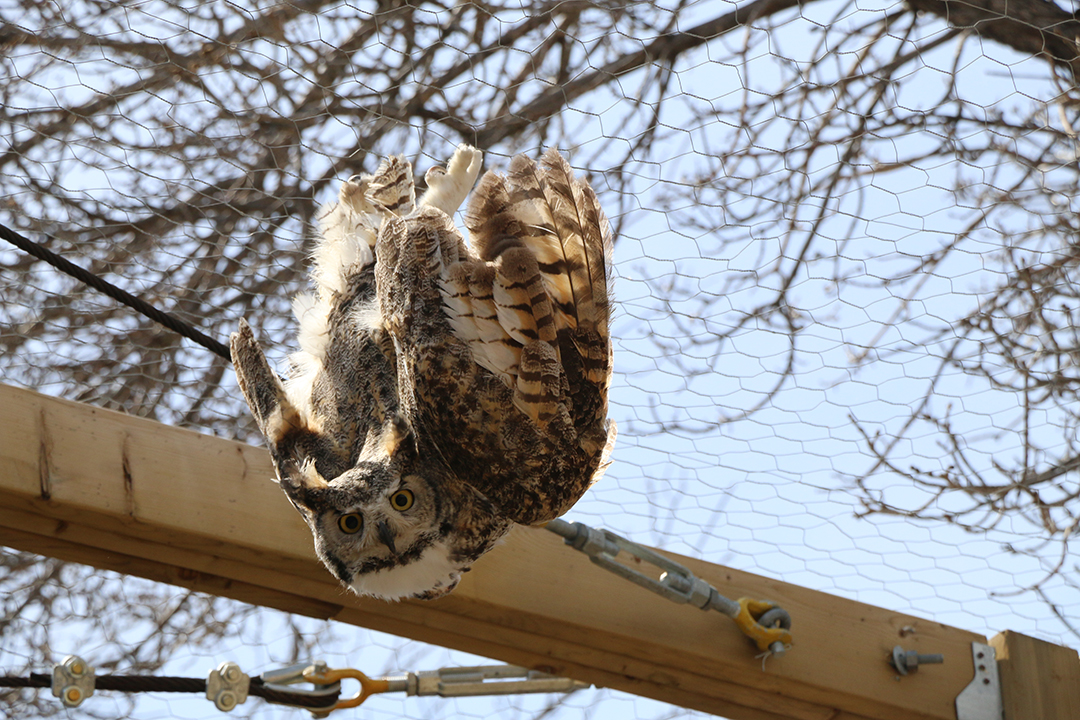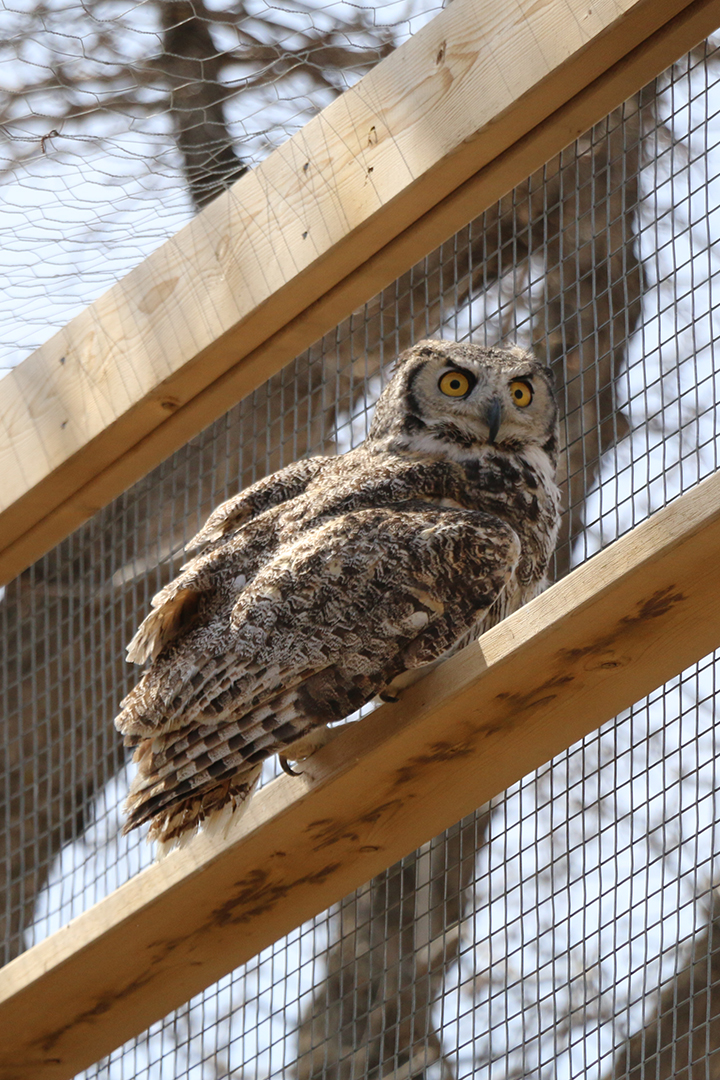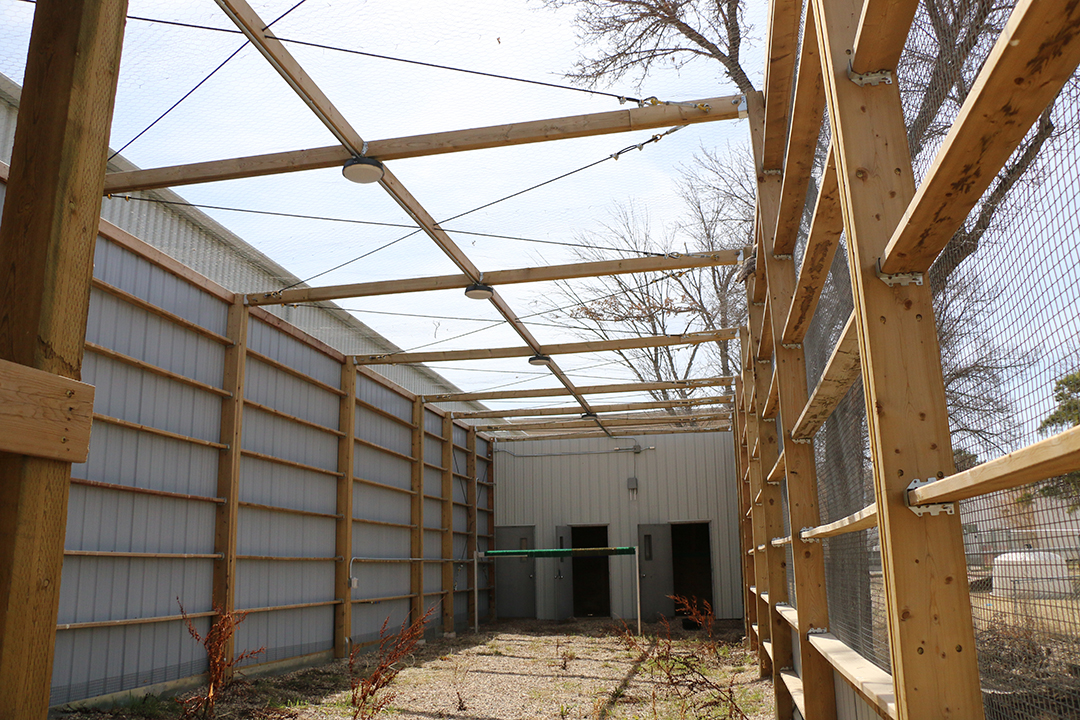
New flight pen is for the birds’ rehabilitation
Veterinarians at the Western College of Veterinary Medicine (WCVM) will be able to better evaluate rehabilitating wild birds and prepare them for release using the college’s newly built flight pen.
By Nykole King
Construction of the flight pen was completed in July 2020, and it became the temporary home for two great horned owls in March 2021. The injured birds came into the care of the college’s Veterinary Medical Centre (VMC) during the winter, and once they’re fully recovered, they will be released this spring.
“It’s been great because we can put the owls out there and they can self-fly,” says Dr. Dennilyn Parker, an associate professor at the WCVM and a specialist in avian, exotic and wildlife medicine. “They've got a lot more room to manoeuvre. It's not just straight back and forth; they can actually use their wings the way they're supposed to.”
It took time and money for the project to finally come together. Funding for the project’s construction came from the WCVM in partnership with fundraising initiatives of the Wild and Exotic Animal Medicine Society (WEAMS), one of the college’s student clubs.
Having a fully functioning flight pen is a substantial change for both the veterinary team and the birds in their care. The WCVM had a flight pen a decade ago, but the temporary structure needed additional maintenance and was eventually torn down due to safety concerns.
As an alternative, WEAMS student volunteers flew the birds in a hallway or on leashes outdoors — methods that prevent the birds from losing conditioning over the winter. However, both options had limitations and didn’t allow team members to fully exercise the birds.
“It can be hard to know sometimes if a bird is able to fly,” says Parker. “Maybe they can fly well enough to get down the hall, but they're not able to manoeuvre enough where they could catch their own food out in the wild, so [the flight pen] lets us assess them better.”
Located behind the VMC’s Large Animal Clinic, the new pen is 80 feet long by 20 feet wide and provides plenty of space for raptors to take flight. The pen’s main area is open air while two smaller rooms off the side offer warm shelter. When needed, hospital staff can also use these extra rooms to separate two bird species so they can use the pen’s main area at alternate times.

When Parker and her team of wildlife veterinarians treat injured or ill wild birds, they often keep the raptors over winter while a local rehabilitation organization take recovering songbirds.
During the winter months, Parker says the two resident owls spent short periods of exercise time in the flight pen. Once the weather improves, the plan is to keep the birds out in the pen all day until their release date.
Although great horned owls don’t necessarily migrate and are able to withstand Saskatchewan winters, Parker prefers to release rehabilitated birds during optimal conditions. Not only is it harder to hunt for food during the winter, but the birds that come into the care of wildlife veterinarians already have “a couple strikes against them.”
“They've been able to adapt to the climate change [from inside to outdoors], and that's really important when we're getting ready to release,” says Parker. She adds that the birds must be “able to maintain their weight when they’re housed outside and not in the artificial condition of having them inside.”
Double doors leading into the pen prevent any escape accident from occurring. Three of the pen’s walls are solid construction while the open-air fourth wall and roof are securely covered with woven wire.
Although the pen has two perches, one owl is known for turning itself upside down and grabbing the pen’s chicken wire “ceiling” with its talons. It’s unusual behaviour for an owl — much more characteristic of bats — but it’s harmless, assures Parker.
While the most significant part of the birds’ treatment and recovery happens inside the WCVM’s Small Animal Clinic, the flight pen allows Parker and her team to do a better job of evaluating the birds and preparing them for release.
“It’s better for the birds if they could be outside and exposed to more natural things. It's more interesting [for them] … as opposed to being inside a room that has nothing really going on inside of it,” says Parker.
